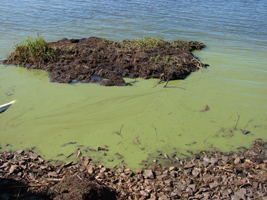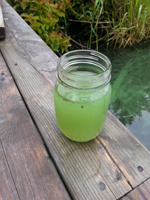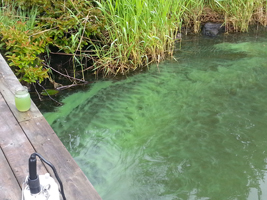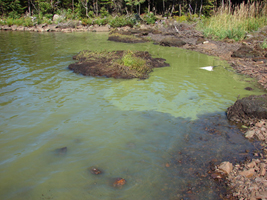Cyanobacteria, also known as blue-green algae (BGA), is a photosynthesizing bacteria naturally found in a variety of habitats but more commonly in warm, shallow, slow-moving freshwater. Cyanobacteria are found throughout the water column, but are most noticeable when they float to the surface, creating a ‘bloom’. Some species of cyanobacteria produce toxins (cyanotoxins) that can potentially impact humans, animals and aquatic life. Research into cyanobacteria species and their potential effects on water quality are ongoing throughout Canada.
Typically, in Canada, cyanobacteria blooms appear in the hot summer months and are prevalent in the prairies. In 2007, the first cyanobacteria bloom was documented in Newfoundland and Labrador by the Department of Municipal Affairs and Environment (now called the Environment and Climate Change). Monitoring of potentially affected water bodies continues as reports of possible blooms are received by the Department.
Frequently Asked Questions (FAQ):
- General Cyanobacteria Questions
- Cyanobacteria Toxins (Cyanotoxins) Questions
- Effects of Toxins on Humans and Animals & Cyanobacteria
- Drinking Water & Cyanobacteria
- Recreational Water & Cyanobacteria
- What’s that weird stuff in the water?
If you would like to report a water quality issues, email water@gov.nl.ca or call 709-729-2535.
More information on blue-green algae monitoring in Newfoundland and Labrador can be found below:
- Field Survey Report Blue‐Green Algae Blooms in Cochrane Pond, Paddy’s Pond, Three Arm Pond and Three Island Pond
- Blue-Green Algae Report 2008
- Blue-Green Algae Monitoring Summary Report (2007-2015)
- Blue-Green Algae Monitoring Summary Report (2016)
- Blue Green Algae Monitoring Summary Report (2017)
- Blue Green Algae Monitoring Summary Report (2018)
- Blue Green Algae Monitoring Summary Report (2019)
- Blue Green Algae Monitoring Summary Report (2020)
- Blue Green Algae Monitoring Summary Report (2021)
- Blue Green Algae Monitoring Summary Report (2022)
Health Canada provides information on blue-green algae at the links below:
- Guidelines for Canadian Recreational Water Quality: Cyanobacteria and their toxins
- Guidelines for Canadian Drinking Water Quality: Cyanobacterial Toxins




